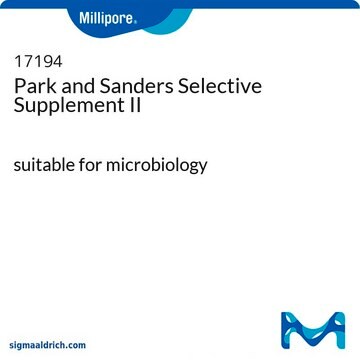ABE1425
Anti-COUP-TF1 Antibody
serum, from rabbit
Sinónimos:
COUP transcription factor 1, COUP-TF1, COUP transcription factor I, COUP-TF I, Nuclear receptor subfamily 2 group F member 1, V-erbA-related protein 3, EAR-3, COUP-TF1
About This Item
Productos recomendados
biological source
rabbit
Quality Level
antibody form
serum
antibody product type
primary antibodies
clone
polyclonal
species reactivity
mouse, human, rat
technique(s)
ChIP: suitable
immunofluorescence: suitable
immunohistochemistry: suitable
western blot: suitable
NCBI accession no.
UniProt accession no.
shipped in
dry ice
target post-translational modification
unmodified
Gene Information
mouse ... Nr2F1(13865)
rat ... Nr2F1(81808)
General description
Specificity
Immunogen
Application
Immunofluorescence Analysis: An 1:500-1000 dilution of a representative lot detected COUP-TF1 immunoreactivity in the developing brain using paraformaldehyde-fixed cryosections from wild-type mouse E13.5 embryos, but not in embryos with brain region-specific COUP-TF1-knockout, by fluorescent immunohistochemistry (Courtesy of Dr. Michele Studer, Institut de Biologie Valrose, France).
Chromatin Immunoprecipitation (ChIP) Analysis: A representative lot detected COUP-TF1 occupancy at the conserved binding sites along the Rnd2 locus using chromatin preparations from the neocortices of E14.5 mouse embryos (Alfano, C., et al. (2011). Development. 138(21):4685-4697).
Western Blotting Analysis: A representative lot detected a higher COUP-TF1 level in retinal and retinal pigment epithelium (RPE) extracts from 24-week-old mice subjected to prorolonged light exposure (24 h/day) than from mice with normal light exposure (12 h/day). Light stress-induced COUP-TF1 upregulation was also observed in RPE, but not retinal extracts from Ranbp2+/− mice (Cho, K.I., et al. (2010). Dis. Model Mech. 3(9-10):595-604).
Western Blotting Analysis: A representative lot detected a 64 kDa form of COUP-TF1 co-immunoprecipitated with RNABP2 from murine retinal extracts (Cho, K.I., et al. (2010). Dis. Model Mech. 3(9-10):595-604).
Immunofluorescence Analysis: A representative lot detected cortex-specific COUP-TFI-knockout in the developing brain of E11.5 COUP-TFIfl/flEmx1Cre transgenic mouse embryos by fluorescent immunohistochemistry staining of paraformaldehyde-fixed cryosections (Armentano, M., et al. (2007). Nat. Neurosci. 10(10):1277-1286).
Immunofluorescence Analysis: A representative lot detected A representative lot detected COUP-TFI immunoreactivity in paraformaldehyde-fixed frozen coronal sections from wild-type E15.5 mouse embryos, but not from COUP-TFI-knockout embryos (Armentano, M., et al. (2006). Development. 133(21):4151-4162).
Immunofluorescence Analysis: A representative lot detected COUP-TF1 immunoreactivity associated with calbindin-positive GABAergic interneurons, but not reelin-positive Cajal-Retzius cells in the developing cortex by dual fluorescent immunohistochemistry using cryosections from E13.5 and E15.5 mouse embryos (Tripodi, M., et al. (2004). Development. 131(24):6119-6129).
Immunohistochemistry Analysis: A representative lot detected a different COUP-TF1 expression pattern than that of COUP-TF2 in the developing telencephalon of forebrain using cryosections from E13.5 mouse embryos (Tripodi, M., et al. (2004). Development. 131(24):6119-6129).
Epigenetics & Nuclear Function
Nuclear Receptors
Quality
Western Blotting Analysis: A 1:500 dilution of this antibody detected COUP-TFI in 20 µg of mouse brain tissue lysate.
Target description
Physical form
Storage and Stability
Handling Recommendations: Upon receipt and prior to removing the cap, centrifuge the vial and gently mix the solution. Aliquot into microcentrifuge tubes and store at -20°C. Avoid repeated freeze/thaw cycles, which may damage IgG and affect product performance.
Other Notes
Disclaimer
Not finding the right product?
Try our Herramienta de selección de productos.
Storage Class
12 - Non Combustible Liquids
wgk_germany
WGK 1
flash_point_f
Not applicable
flash_point_c
Not applicable
Certificados de análisis (COA)
Busque Certificados de análisis (COA) introduciendo el número de lote del producto. Los números de lote se encuentran en la etiqueta del producto después de las palabras «Lot» o «Batch»
¿Ya tiene este producto?
Encuentre la documentación para los productos que ha comprado recientemente en la Biblioteca de documentos.
Nuestro equipo de científicos tiene experiencia en todas las áreas de investigación: Ciencias de la vida, Ciencia de los materiales, Síntesis química, Cromatografía, Analítica y muchas otras.
Póngase en contacto con el Servicio técnico






